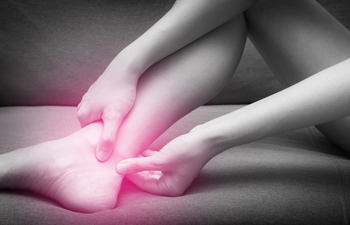What Is an Achilles Tendon Rupture?
Tuesday, 18 January 2022 00:00The Achilles tendon is a band of fibrous tissue that connects your calf muscles to your heel bone. Though this tendon is tough, it can tear or rupture during physical activity. A ruptured Achilles tendon can cause many symptoms, including a sharp, sudden pain at the back of the ankle, difficulty walking, weakness, and an inability to raise the injured foot. Some people are able to walk or continue playing sports with a ruptured Achilles tendon due to the surrounding muscles compensating. However, this can make the injury worse. A rupture can be treated conservatively or with surgery. Conservative treatment typically involves immobilizing the injured leg with a cast to allow it to heal. Surgery repairs the ruptured tendon. If you believe that you may have ruptured your Achilles tendon, it is strongly suggested that you seek the care of a podiatrist.
Achilles tendon injuries need immediate attention to avoid future complications. If you have any concerns, contact John Horlebein, DPM of Northern Cascades Foot & Ankle, LLC. Our doctor can provide the care you need to keep you pain-free and on your feet.
What Is the Achilles Tendon?
The Achilles tendon is a tendon that connects the lower leg muscles and calf to the heel of the foot. It is the strongest tendon in the human body and is essential for making movement possible. Because this tendon is such an integral part of the body, any injuries to it can create immense difficulties and should immediately be presented to a doctor.
What Are the Symptoms of an Achilles Tendon Injury?
There are various types of injuries that can affect the Achilles tendon. The two most common injuries are Achilles tendinitis and ruptures of the tendon.
Achilles Tendinitis Symptoms
- Inflammation
- Dull to severe pain
- Increased blood flow to the tendon
- Thickening of the tendon
Rupture Symptoms
- Extreme pain and swelling in the foot
- Total immobility
Treatment and Prevention
Achilles tendon injuries are diagnosed by a thorough physical evaluation, which can include an MRI. Treatment involves rest, physical therapy, and in some cases, surgery. However, various preventative measures can be taken to avoid these injuries, such as:
- Thorough stretching of the tendon before and after exercise
- Strengthening exercises like calf raises, squats, leg curls, leg extensions, leg raises, lunges, and leg presses
If you have any questions please feel free to contact our office located in Chelan, WA . We offer the newest diagnostic tools and technology to treat your foot and ankle needs.







